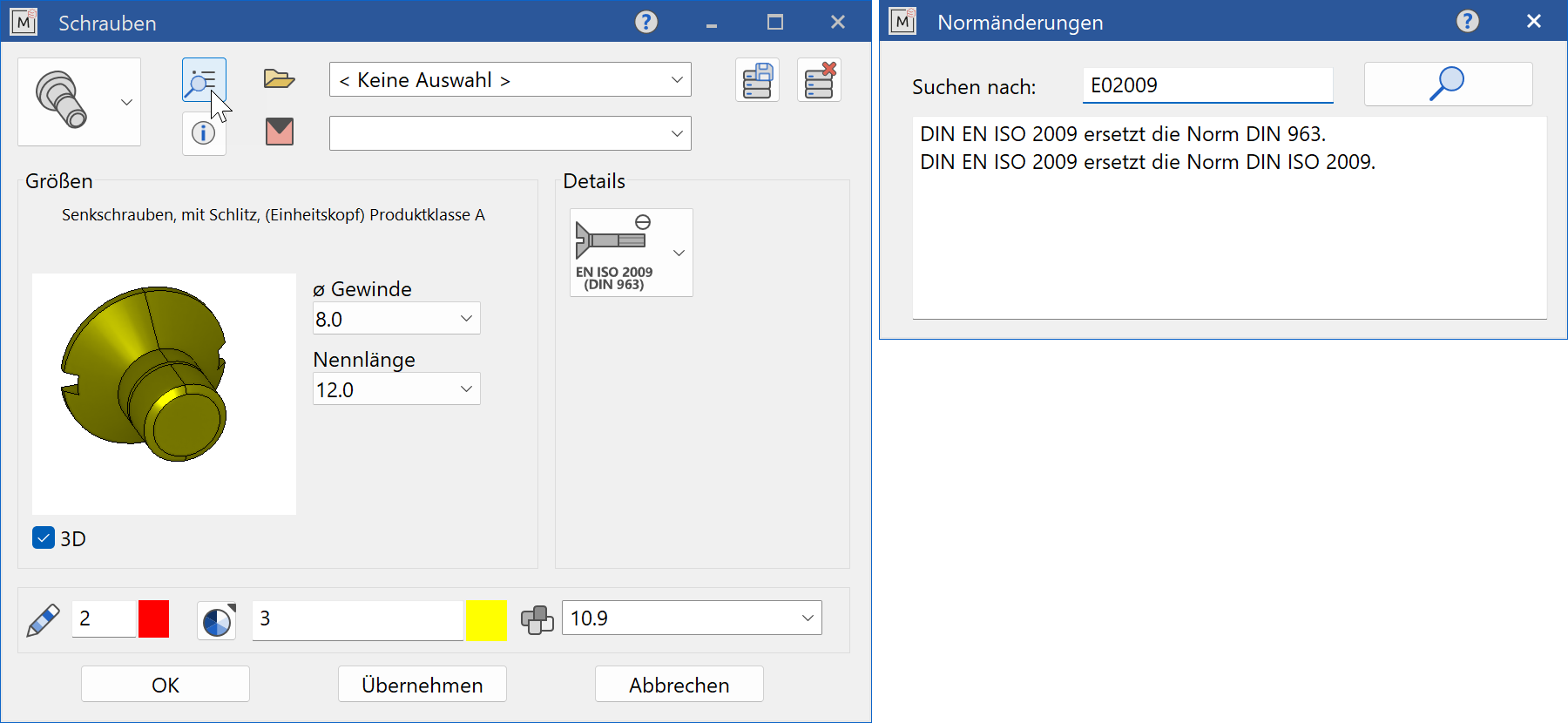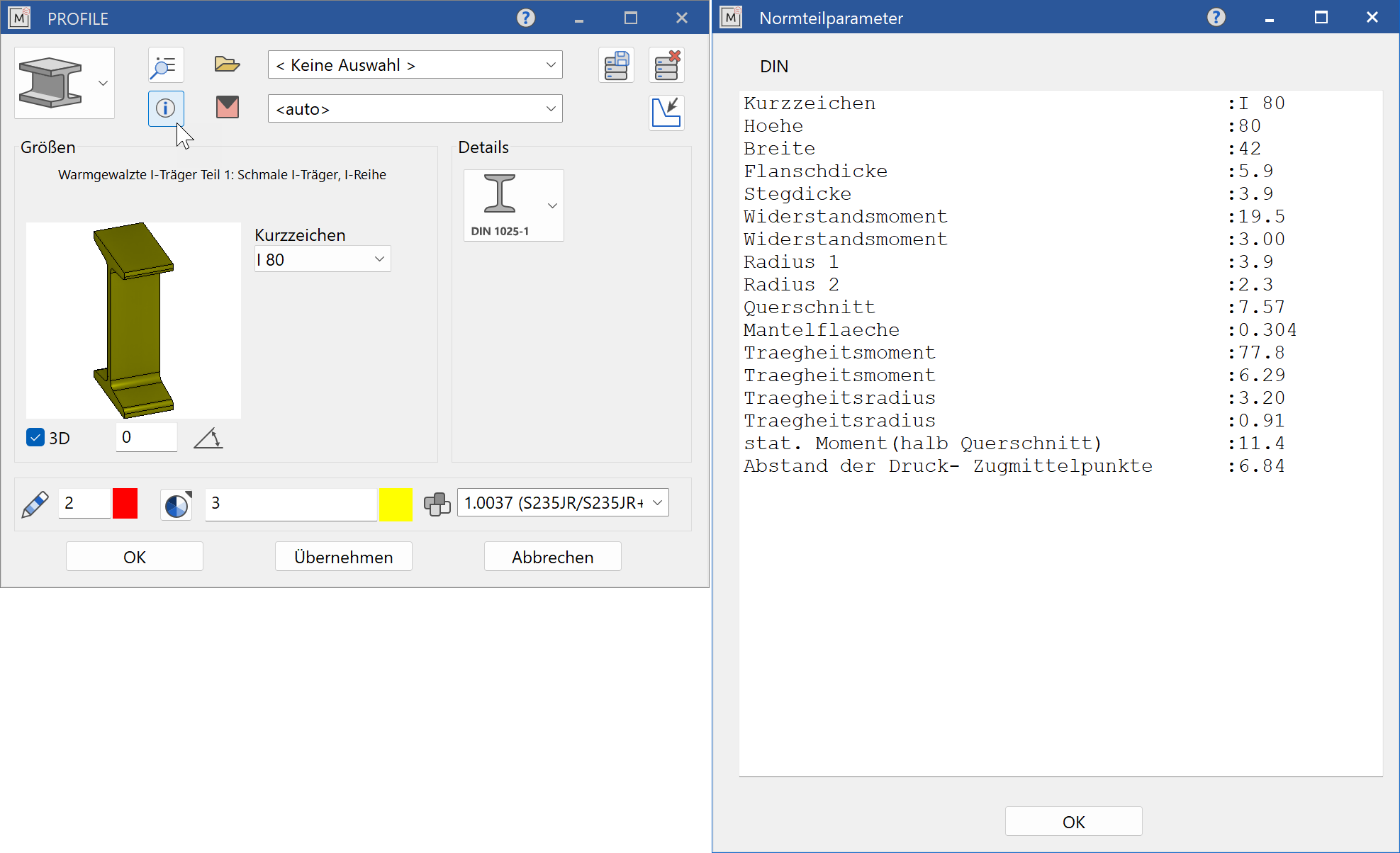General Parameters¶
In the property bar and in the main parameter dialog window for standard parts, some parameters and functions are universal for all standard parts and are described in this chapter for all types.
The name entered as well as the material assignment and the dimensions are stored in attributes and can be called up for the bill of material evaluation.
Name¶

The name of the an object can be set here simply by entering it in the text field.
Tip
With the text "
Material¶

The assigned material is added as an attribute and shown under material in the bill of material. With the existing volume, the weight of the component is automatically determined. In addition, hatching is preset for the cut surface. The prerequisite for the calculation to work is a defined material with a specific weight in the database.
View depiction for 2D¶
Left side view
Top view
Right side view
Bottom view
Front view
Rear view
Under the selection of the standard part you will find the selection switch for the required 2D view depiction.
In 3D mode, the standard part can be rotated and zoomed as required with the mouse.
Colour/Material¶

The colour and transparency as well as the material for the 3D depiction can be selected here.
Colour mode/Material mode¶
![]()
![]()
This switch allows you to toggle between colour mode and material mode. For more details, see the Colours and Materials chapters.
Line type¶
The line type for 2D depiction can be selected here.
Objects parameters¶
Improved · 16 R1 · Improvements
Object parameters are settings that can be made in the parameter dialog of an object. The settings can be saved as a data record for each type of object.
Record¶
Selection with the predefined data sets.

![]() SAVE RECORD
SAVE RECORD
In order to create your own type, the parameter dialog window of the standard part is filled out as required, then a new name is entered in the text field and saved.
![]() DELETE RECORD
DELETE RECORD
This menu item is used to delete a record that is no longer required.
Help¶
With the HELP function, the ELITECAD Help Center is opened on a topic-related basis.
Info¶
![]() PREDECESSOR
PREDECESSOR
With the PREDECESSOR function, you get the possibility to search for predecessors of the specified standard and to get information about their replacement.

DETAILS
With the DETAILS function, you get a list with all information and data for the selected standard part supported by the standard table. There you will find detailed information on the profile dimensions as well as information on the areas, moments of inertia and resistance.

Description of standard parts¶
Improved · 16 R1 · Improvements
The standard part description is always located above the standard part view. In the event that the standard part description text does not fit into this field, there are also tool tips that always show the entire standard part description text. The tool tip is shown when the cursor pauses over the standard parts preview window.
Modify standard part¶
The easiest way to change standard parts that have already been generated is to select the object with the mouse. The property bar of the standard part appears with the most important parameters. With a double-click on the object, the large parameter window is also opened and all current input values are displayed. Other options for opening the parameter window are the function MODIFY > ME-OBJECT or choosing EDIT in the context menu EDIT on the current selection.
Tip
If you have a large number of identical standard parts, we recommend the following:
Use the basic CAD function for copying standard parts. All standard parts are clearly identifiable as objects and can thus be manipulated as required with the cursor snap functions.
Various attributes are assigned to the object by the system for the bill of material evaluation. Before copying, check and complete all non-graphic information that you need for your bill of material by going to LAY OUT > ATTRIBUTES.
The parameters for the depiction of the thread lines of the hidden lines and for the centre lines are defined by going to SETTINGS > OPTIONS > WORK PARAMETERS > MECHANICAL LINES.